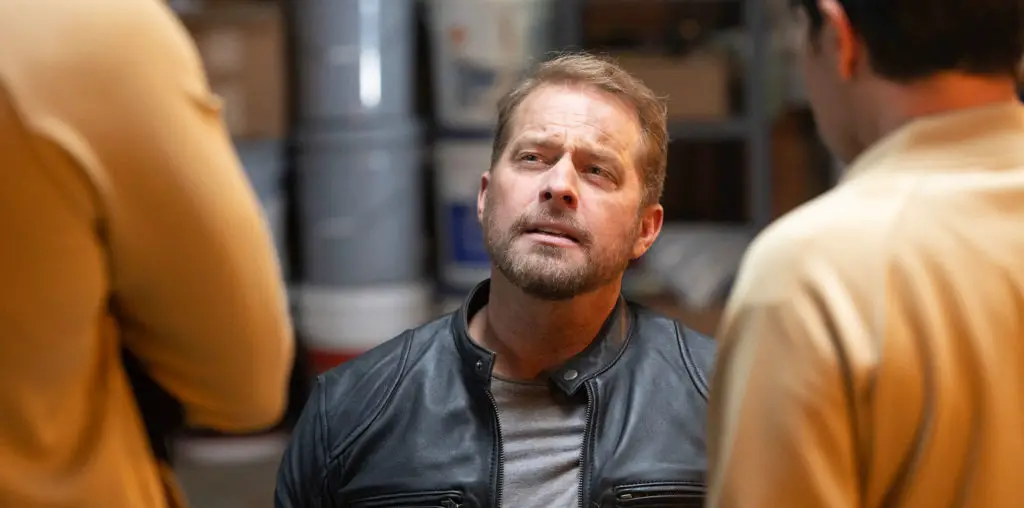
When a prisoner of war engages in a dangerous battle of wits with his sadistic captor, the lines of demarcation between them blur and disintegrate. Who the true victim is, in the end, is questionable.
Jessica Habie’s Mars At Sunrise is an experimental narrative film that explores the ongoing middle-eastern conflict in ways far different than her accustomed documentary style. The plot is roughly based upon the illegal incarceration and systematic torture of Palestinian artist Hani Zurob in 2002, and proceeds somewhat as expected:
A Palestinian artist named Khaled (Ali Suliman) lives in Jerusalem and teaches art at a local school. When Khaled learns that his studio/residence is now within Israeli borders, he is forced to move nearer his parents, in Ramallah. Shortly thereafter, he is arrested by Eyal (Guy Elhanan), an Israeli soldier and failed artist. Eyal, as a lone vigilante, accuses Khaled of subversive collaborations with the militant movement, Hamas, and detains him in a primitive oblong space underground. There, Eyal tortures and interrogates his captive with no allowance for sleep for either one of them. Several months later, Eyal abruptly releases his prisoner.
What is immediately noticeable about Mars At Sunrise is its novel approach to the Arab-Israeli struggle. Instead of favoring one side or the other, as most filmmakers are prone to do, Habie zooms in on the psyche of each man, showing their surprising likenesses. She does this through fractured-narrative, color, flashbacks, poetic-voiceover, and music-as-character. While this experimental-dreamscape journey into the inner minds of her principal characters may not appeal to some, I think that Habie’s competence in this arena makes her plot far easier to understand than if the story were told in linear fashion. What Habie manages to capture is how most people would think were they in similar circumstances, and this universalism is what makes her film both frightening and riveting at the same time.
Words obviously play an important role in the film— both as verbiage we can hear (as for example, outside sounds of explosives, Eyal’s constant questioning and Khaled’s controlled responses), and gestures we can read in the faces and body language of her characters. As viewers, we are always on the outside, observing, as if through that two-sided glass at prisons. This discomfort at our end, juxtaposed with the reactively brewing claustrophopic-paranoia on the part of the characters, creates a disturbance that can’t be ignored. Thus, we aren’t the least bit shocked when Khaled admits that looking at the sun (contrived by his drawings) is his only escape from the external and internal words that haunt him.
By the same token, Eyal suffers just as much— and this should be noted— as much as we’d prefer to look away from the hateful soldier who threatens the film’s more desirable hero. What we should also keep in mind as we watch the film is that the very beaten Khaled is often an instigator, dredging up the emotions Eyal would rather bury within. This continuous mind-play between captive and captor keeps the story alive so there is never any downtime for viewer-boredom.
The music also stands in as both internal and external characters, not simply for the principals, but for people we can and can’t see. These include Khaled and Eyal’s family, medical personnel, innocent children, exhausted checkpoint soldiers, terrorists, and average townspeople just trying to live their lives. It is here that composer Tamir Muskat shines, with a beatific, global range representative of Jews, Palestinians, and everyone in between. Again, the musical score strengthens that sense of universalism so prevalent in the movie, along with its provocative surrealism.
The use of color as a tool of expression is something that should be noted in Mars At Sunrise. Habie uses this as a powerful, expressive device in somewhat the same way as Paul Thomas Anderson does in Punch-Drunk Love. Thus, we see the vivid reds symbolizing Khaled’s spilled blood, and colors in competition with blacks, whites and grays, as a method of defeating post traumatic stress, and moving on from a dire experience.
In many ways, Mars At Sunrise calls to mind such legendary films as Roman Polanski’s Death and the Maiden (1994), Hiroshi Teshigahara’s Woman in the Dunes (1964), Asa Mader’s The Malady of Death (2003), based upon Marguerite Duras’ novel of the same name, and of course, Awaiting Oblivion, by the French experimental, writer/philosopher, Maurice Blanchot. In all of these tales, wordplay and mind-games intrinsically threaten, and escape becomes a necessity, no matter the hazards involved.
What I most appreciate about Habie’s little cinematic gem is that it ends on an uncontrived, completely believable up beat. What we learn is that the human spirit really is invincible, and can overcome any obstacle life throws its way.
The only flaw I see in Mars At Sunrise is a technicality concerning white subtitles. I find them difficult to read in some scenes, and would much prefer letterboxed subtitles that look well even against a white field. This very fixable issue is the only reason I did not give
Mars At Sunrise the perfect 5-star rating it deserves.
